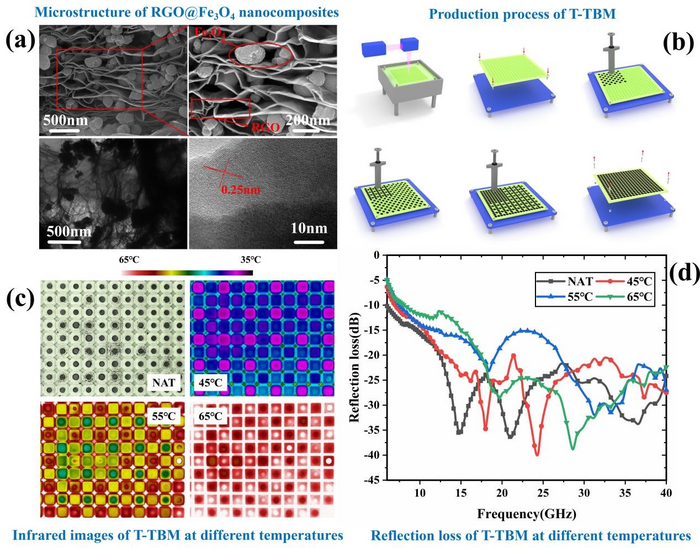Reviewed by Alex SmithNov 28 2022
Researchers guided by Professor Xiaoyong Tian in the State Key Laboratory for Manufacturing Systems Engineering at Xi’an Jiaotong University have engineered a thermo-tunable broadband metamaterial (T-TBM) by three-dimensional (3D) printing.
 (a) Microstructure of RGO@Fe3O4 nanocomposites; (b) production process of T-TBM; (c) infrared images of T-TBM at different temperatures; (d) reflection loss of T-TBM at different temperatures. Image Credit: Xiao-Chang Xing.
(a) Microstructure of RGO@Fe3O4 nanocomposites; (b) production process of T-TBM; (c) infrared images of T-TBM at different temperatures; (d) reflection loss of T-TBM at different temperatures. Image Credit: Xiao-Chang Xing.
The T-TBM’s electromagnetic (EM) response can be modified by regulating the solid-liquid phase state of diverse metamaterial units. In contrast to formerly reported active control metamaterials, the T-TBM’s absorption response can be regulated by temperature alteration; moreover, its performance of ultra-wideband absorbing does not alter with the temperature.
The researchers state that the T-TBM can also boost the development of intelligent metamaterials and thermally regulated absorbers.
The team initially made RGO@Fe3O4 nanocomposites in this research using a mechanical technique. The characterization outcomes of the RGO@Fe3O4 nanocomposites verified that the RGO@Fe3O4 nanocomposites with the sandwich structure were effectively prepared.
Then, paraffin-based composites (PD-Cs) were effectively prepared by incorporating 15 wt% RGO@Fe3O4 nanocomposites into paraffin with diverse phase transition temperatures.
It has been demonstrated that the PD-Cs possess superior electromagnetic loss performance with steady phase transition behavior (the phase transition behavior does not alter with incorporating RGO@Fe3O4 nanocomposites). Established on the physical parameters’ test of the PD-Cs, the researchers engineered and enhanced the structure of the T-TBM using ANSYS HFSS 16.0.
Furthermore, the structure’s absorbing performance is replicated and tested. The experimental outcomes illustrate that the T-TBM has the property of ultra-wideband absorbing and can change the absorbing peak (reflection loss is less than −30 dB) at diverse temperatures.
However, the variation in temperature does not change the T-TBM’s ultra-wideband microwave absorbing performance. In the end, the researchers examined the micro-mechanism of thermo-tunable absorbing properties of the T-TBM.
The findings illustrate that the various micro-morphologies of the conductive network developed by RGO@Fe3O4 nanocomposites during the phase transition of PD-Cs have a vital role in the thermal control mechanism of the T-TBM.
Journal Reference:
Xing, X-C., et al. (2022) A Thermo-Tunable Metamaterial as an Actively Controlled Broadband Absorber. Engineering. doi.org/10.1016/j.eng.2022.04.028.